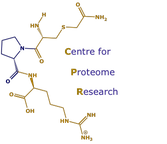Complete de novo sequencing of a mouse lemur protein
Jennifer Unsworth, Grace M. Loxley, Amanda Davidson, Jane L. Hurst, Guadalupe Gómez-Baena, Nicholas I. Mundy, Robert J. Beynon, Elke Zimmermann & Ute Radespiel. (2017) Characterisation of urinary WFDC12 in small nocturnal basal primates, mouse lemurs (Microcebus spp.) [PDF] [PUBMED] Scientific Reports | 7:42940 | DOI: 10.1038/srep42940
Mouse lemurs are basal primates that rely on chemo- and acoustic signalling for social interactions in their dispersed social systems. We examined the urinary protein content of two mouse lemurs species, within and outside the breeding season, to assess candidates used in species discrimination, reproductive or competitive communication. Urine from Microcebus murinus and Microcebus lehilahytsara contain a predominant 10 kDa protein, expressed in both species by some, but not all, males during the breeding season, but at very low levels by females. Mass spectrometry of the intact proteins confirmed the protein mass and revealed a 30 Da mass difference between proteins from the two species. Tandem mass spectrometry after digestion with three proteases and sequencing de novo defined the complete protein sequence and located an Ala/Thr difference between the two species that explained the 30 Da mass difference. The protein (mature form: 87 amino acids) is an atypical member of the whey acidic protein family (WFDC12). Seasonal excretion of this protein, species difference and male-specific expression during the breeding season suggest that it may have a function in intra- and/or intersexual chemical signalling in the context of reproduction, and could be a cue for sexual selection and species recognition.
Mouse lemurs are basal primates that rely on chemo- and acoustic signalling for social interactions in their dispersed social systems. We examined the urinary protein content of two mouse lemurs species, within and outside the breeding season, to assess candidates used in species discrimination, reproductive or competitive communication. Urine from Microcebus murinus and Microcebus lehilahytsara contain a predominant 10 kDa protein, expressed in both species by some, but not all, males during the breeding season, but at very low levels by females. Mass spectrometry of the intact proteins confirmed the protein mass and revealed a 30 Da mass difference between proteins from the two species. Tandem mass spectrometry after digestion with three proteases and sequencing de novo defined the complete protein sequence and located an Ala/Thr difference between the two species that explained the 30 Da mass difference. The protein (mature form: 87 amino acids) is an atypical member of the whey acidic protein family (WFDC12). Seasonal excretion of this protein, species difference and male-specific expression during the breeding season suggest that it may have a function in intra- and/or intersexual chemical signalling in the context of reproduction, and could be a cue for sexual selection and species recognition.
